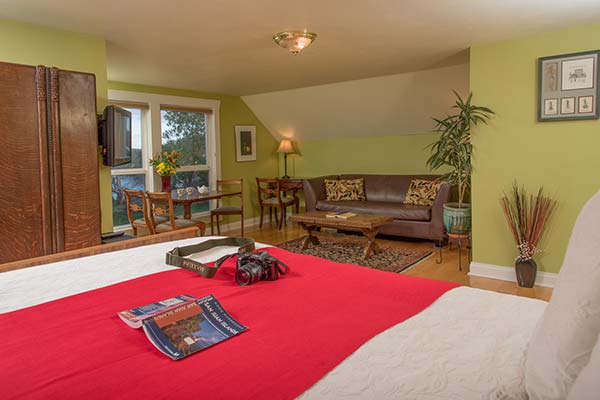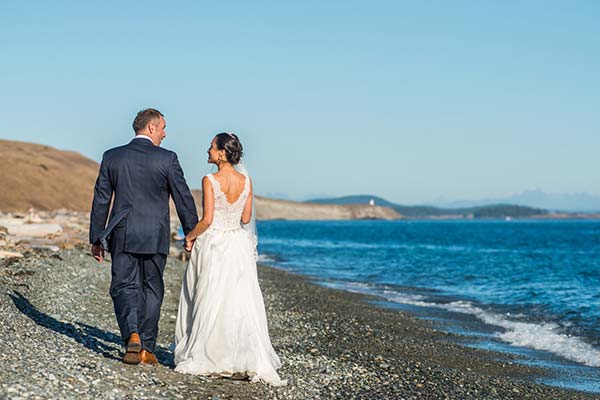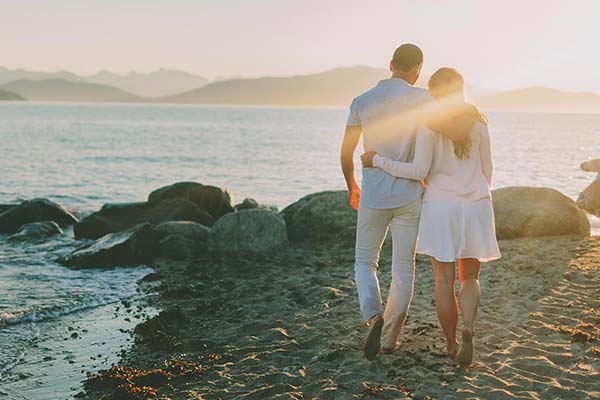- Anna Maria and Dave recently enjoyed a well-deserved vacation in Hawaii, and she shared with me the story of an incredible whale encounter that they had. As we approach the start of whale-watching season here on San Juan Island, I wanted to share it with all of you. We hope it inspires you to book your own whale-watching tour when you come to visit us. Read more about their amazing humpback encounter below.
“Some folks are just charmed when it comes to whale-watching. Dave and I have lived on San Juan Island for 10 years, and unfortunately don’t consider ourselves part of that esteemed group. We live vicariously through our guests and their life-changing orca encounters. We drool over their photos, or after learning they were splashed by a breach or exhalation when standing on the shore by the Lime Kiln lighthouse. Despite the strict rule that boats must remain 200 yards away from the whales, many of our guests have experienced a spy-hop or breach behavior right off the port side of the boat. Our whale-watching fortune is not for lack of effort either, by shore or boat. I can remember multiple occasions when we would get the call from a local whale watch operator alerting us to whales in the area. We would drop everything and dash to the west side of the island, only to end up despondently watching them swim across the channel. We could barely make out their dorsal fins above the water.
On our recent holiday in Hawaii, our luck suddenly changed. We were casually looking across the water by a lighthouse on Kauai, and there in front of us was a blow, and then another, a few yards away. Before we knew it we forgot about the lighthouse and were staring across the blue expanse, riveted at the prospect of seeing more whales.
Over the next three weeks, we spotted humpback whales almost every day as we traveled throughout the islands. About 4,500 humpbacks migrate from the icy Alaskan waters each fall and make a beeline for Hawaii’s tropical climate, where they mate, give birth
to and nurture their calves. Their annual migration of about 6,000 miles is the longest of any mammal. As soon as we spotted the telltale blow, we would immediately pull the car to the shoulder or a nearby beach and stand mesmerized. I found myself talking to them from afar, cheering and clapping as they went through their antics, showing off just for us. As soon as they moved out of our view, we would get back in the car and continue driving in their direction to get an opportunity to find another vantage to continue watching them.
We did quite a bit of boat diving. As soon as someone said whales off the bow, the entire group of suited up divers focused as one on the open water. At one point, we lost track of the dive briefing when a mother humpback and her calf were playing in the waters just off our boat. On one hand, we didn’t want to miss a breach or close encounter topside, but we were anxious to get underwater for the chance of seeing the magnificent animals in their watery territory. There were several dives during which their singing was so loud, that there was no doubt that they were close by. I found myself turning away from the reef and staring into the deep blue water, looking for the looming shadow of a humpback. We never did see them underwater, but as soon as we surfaced from our dive, the captain told us about the massive breach that he saw off the stern of the boat. We tried to coordinate the timing of the breach topside with a dramatic change of the singing underwater.
Observing and hearing humpbacks was one of the highlights of our trip. It was an adventure, and every encounter a wonderful gift. We experienced firsthand the same excitement our guests do when they come to the islands and see orcas in the wild. Many guests have the good fortune of seeing humpbacks here too; they made a huge resurgence this year, in addition to the Minke whales that also frequent our waters. When you plan your visit, make sure that a whale watch trip is a part of your itinerary. Our concierge will be happy to make reservations for you and have vouchers awaiting your arrival at check-in. Now that our luck has changed, we can’t wait to head down to Lime Kiln or jump on a whale watch boat to look out over the water for that unmistakable sign of our black and white icons.”
As Anna Maria said, the main whale that folks travel here to see are the orcas, or killer whales. We have two main types of orca that frequent our waters – resident and transients. Resident orcas feed strictly on fish; 80% of our resident orcas’ diet is Chinook salmon. Transient orcas feed strictly on marine mammals, such as seals and sea lions, dolphins and porpoises; sometimes even other whales. Yours truly, not just a blogger but also a naturalist, once witnessed a group of transient orcas take down a large male deer as it attempted to swim from island to island, as they often do. Fortunately, we are flush with deer in the San Juan Islands, and so it was an incredible experience to watch such an awe-inspiring act of nature.
Humpback whales are not seen as often as the orcas are, but we spotted over 5 different humpbacks in the summer of 2013, which is almost an unheard of number for this area. Humpbacks are incredible animals; they complete an annual migration every year. They give birth in the warm, sheltered waters of Mexico in the winter months, then travel back up the western coast of North America with their newborn calves to head to Alaska and feed on the abundance there. Transient orcas have been known to work in teams and separate newborn humpbacks from their mothers; to them, a large whale like a humpback is a prime meal. I’ve never witnessed that, and it doesn’t happen very often in our part of the world; more likely in the open ocean.
If you do decide to come see our orcas in their natural habitat, you won’t regret it. There’s a good chance you will witness some of their natural social behaviors such as spyhopping, breaching and porpoising. Orcas are extremely social creatures; they depend on their family bonds for survival and mental stimulation. Orcas can swim over 100 miles in a single day, so it’s not unusual for them to be on the west side of San Juan Island in the morning and halfway to the top of Vancouver Island by the end of the day. Come try your luck at seeing them, in the only part of the continental United States that such a thing is possible. How lucky we are to have these amazing animals in our backyard!







